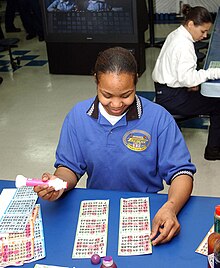
Back Бинго Bulgarian Bingo Catalan Bingo Danish Bingo German Bingo Esperanto Bingo Spanish Bingo Estonian Bingo Basque بینگو Persian Bingo Finnish
This article needs additional citations for verification. (October 2023) |
 | |
| Years active | 1920s to present |
|---|---|
| Chance | Extremely high |
| Age range | Varies |
In the United States and Canada, bingo is a game of chance in which each player matches the numbers printed in different arrangements on cards. The game host (known as a caller) draws balls at random, marking the selected numbers with tiles. When a player finds that the selected numbers are arranged on their card in a horizontal, vertical, or diagonal line, they call out "Bingo!" to alert all participants to a winning card, which prompts the game host (or an associate assisting the host) to examine the card for verification of the win. Players compete against one another to be the first to have a winning arrangement for the prize or jackpot. After a winner is declared, the players clear their number cards of the tiles and the game host begins a new round of play.
Alternative methods of play try to increase participation by creating excitement. Since its invention in 1929, modern bingo has evolved into multiple variations, with each jurisdiction's gambling laws regulating how the game is played. There are also nearly unlimited patterns that may be specified for play. Some games require only one number to be matched, while cover-all games award the jackpot for covering an entire card. There are even games that award prizes to players for matching no numbers or achieving no pattern.